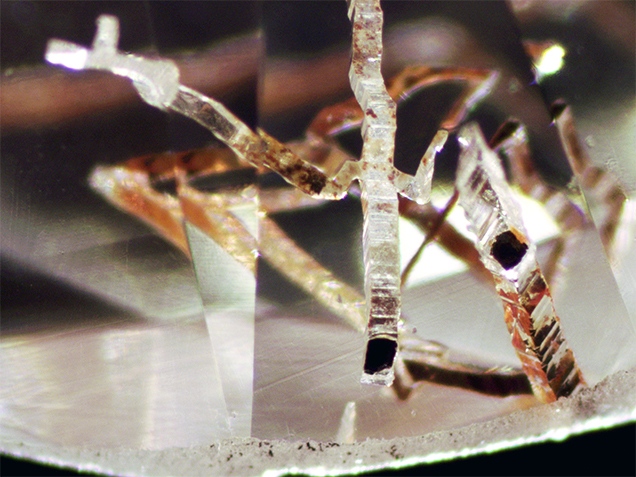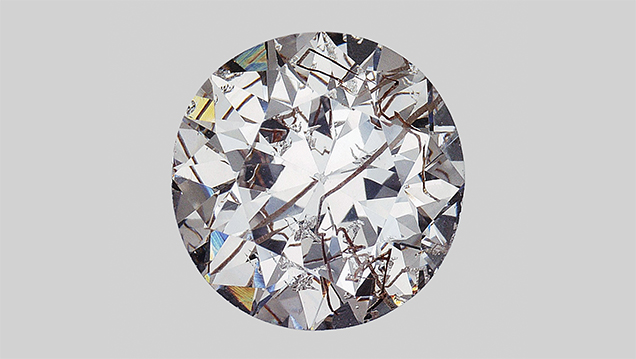I often get asked questions regarding diamonds:
“What is diamond clarity?”
“Why is this diamond slightly yellow?”
“How can I find a good diamond engagement ring?”
But one of the rarer questions is this — What is an etch channel? It’s not a common question, but etch channels themselves can be common. The first time you may stumble across them is in the diamond plot graph that is included on every GIA certificate. Let’s delve into this.
- What is an Etch Channel?
- Do Etch Channels Affect Diamond Value?
- Do Etch Channels Affect Diamond Durability?
What is an Etch Channel?
As diamonds are formed over millennia in the hot pressure of the Earth’s mantle, they can come under some wear and tear. Anyone would under such circumstances. In almost all cases, diamonds either develop blemishes (imperfections on the outside of the diamond) or inclusions (imperfections on the inside of the diamond.
Blemishes usually occur during a diamond’s life as jewelry, through human accident or interaction. Inclusions develop when diamonds are being formed, and they’re far more common than you think. Even the highest quality diamonds can contain these inclusions, but usually they are imperceptible to the human eye.
An etch channel in a diamond is an inclusion. It is a ‘hollow tunnel’ that runs from the surface of the diamond into the diamond’s body. They can exist in a multitude of forms, from maze-like structures to straight parallel lines.
 This is a pretty rare example of etch channels that are highly pronounced. They can at times look a little as if branches of a tree have grown through a diamond. Image credit: GIA
This is a pretty rare example of etch channels that are highly pronounced. They can at times look a little as if branches of a tree have grown through a diamond. Image credit: GIA
Etch channels are believed to be formed during the movement of a diamond from the Earth’s mantle to the surface. As they are conveyed upwards by natural processes, high-temperature liquids can bore into the structure of the diamond.
Discover More Diamond Education
So if you would like to learn more about these precious stones, head to my diamond education page or the YourDiamondGuru blog.
Do Etch Channels Affect Diamond Value?
Like any inclusion, etch channels will impact how a diamond is graded, and therefore what its final price will be. However, in very rare cases a diamond can have such unique etch channels that it may make the diamond more interesting and valuable to certain parties. That being said, I would not recommend buying a diamond if the etch channels are highly extensive. Like any diamond, you must review them on a case-by-case basis.
 This diamond that was shown on the GIA website is an example of extraordinary etch channels. While I’m not sure I’d be interested in buying it, it is a very impressive example of both how unique diamonds can be, and the power of Nature’s natural processes. Image credit: GIA
This diamond that was shown on the GIA website is an example of extraordinary etch channels. While I’m not sure I’d be interested in buying it, it is a very impressive example of both how unique diamonds can be, and the power of Nature’s natural processes. Image credit: GIA
In cases where the etch channels are not deep, a diamond cutter will usually polish them out. However, if they are deep, there’s no sense in removing a lot of excess weight from the diamond just to get rid of them.
Do Etch Channels Affect Diamond Durability?
There will always be concerns about durability if a diamond has large, noticeable inclusions. I will always advise thinking twice before purchasing a diamond with a large inclusion, as this can weaken the integrity of the diamond, meaning it is more likely to break or shatter under pressure.
So do etch channels affect durability? It depends. A diamond with a low clarity grade, such as SI2 or I1 will potentially have durability issues. However, a diamond with VS2 or above will probably have no problems with integrity, even if it has etch channels. Remember to always look for an eye-clean stone, as these will represent the best quality in terms of durability.
If a diamond has etch channels that are found on the pavilion side, don’t buy them. Over time, diamonds can get dirty (they’re usually easy to clean), so if dirt finds its way inside etch channels on the pavilion, they become a nightmare to clean properly once placed in a setting.
If you find a diamond with etch channels at a reputable vendor, the chances are that diamond has been found to be structurally sound. For example, if Whiteflash exhibit a diamond that has etch channels, it is because the in-house team has judged it fit to sell. Some less reputable vendors cannot be trusted in the same way.
My Final Verdict
As with any diamond purchasing process, always judge the specific diamond you’re looking at, rather than picking randomly from a range. If you can look at a diamond in person, fantastic. This allows you to see exactly what you’re buying and if there are any issues.
However, if you’re buying online, consider the following:
- Is the diamond eye-clean?
- Is the diamond VS2 clarity or better?
- Is the diamond in the colorless or near-colorless range?
- Does the diamond have a good quality cut?
Answering these questions will help you narrow the range of diamonds you can buy, which is a very good thing, as you’re more likely to get something worth the money you spend on it.
When it comes to etch channels, weigh up the following:
- Are the etch channels large enough to affect light performance?
- Are the etch channels large enough to affect durability?
- Are they large enough to affect the visual appeal of the diamond?
- Are they large enough to limit the value you can get upon potential resale?
If the answer to the first one is ‘yes’, then it’s probably ‘yes’ for the others as well.

Richard Jenkins, The Diamond Guru
Get free assistance from the Diamond Guru today. You’ll be glad you did!
- Secure the best quality diamond for your budget.
- Don’t pay over the odds for your diamond ring.
- Have peace of mind that you didn’t get ripped off.
Have a Question? Contact us now…

